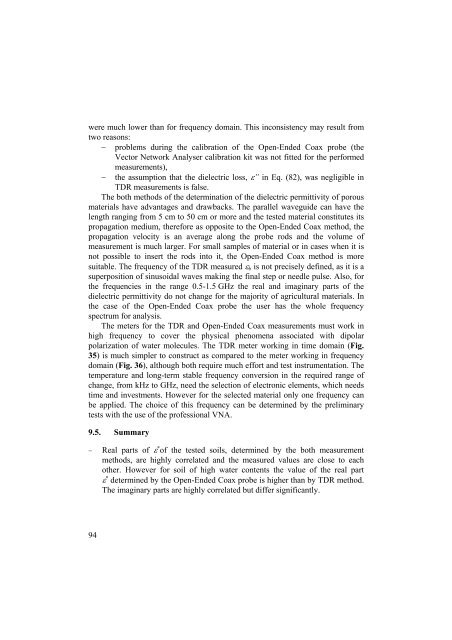ekS - Instytut Agrofizyki im. Bohdana DobrzaÅskiego PAN w Lublinie ...
ekS - Instytut Agrofizyki im. Bohdana DobrzaÅskiego PAN w Lublinie ...
ekS - Instytut Agrofizyki im. Bohdana DobrzaÅskiego PAN w Lublinie ...
You also want an ePaper? Increase the reach of your titles
YUMPU automatically turns print PDFs into web optimized ePapers that Google loves.
were much lower than for frequency domain. This inconsistency may result from<br />
two reasons:<br />
− problems during the calibration of the Open-Ended Coax probe (the<br />
Vector Network Analyser calibration kit was not fitted for the performed<br />
measurements),<br />
− the assumption that the dielectric loss, ε” in Eq. (82), was negligible in<br />
TDR measurements is false.<br />
The both methods of the determination of the dielectric permittivity of porous<br />
materials have advantages and drawbacks. The parallel waveguide can have the<br />
length ranging from 5 cm to 50 cm or more and the tested material constitutes its<br />
propagation medium, therefore as opposite to the Open-Ended Coax method, the<br />
propagation velocity is an average along the probe rods and the volume of<br />
measurement is much larger. For small samples of material or in cases when it is<br />
not possible to insert the rods into it, the Open-Ended Coax method is more<br />
suitable. The frequency of the TDR measured ε b is not precisely defined, as it is a<br />
superposition of sinusoidal waves making the final step or needle pulse. Also, for<br />
the frequencies in the range 0.5-1.5 GHz the real and <strong>im</strong>aginary parts of the<br />
dielectric permittivity do not change for the majority of agricultural materials. In<br />
the case of the Open-Ended Coax probe the user has the whole frequency<br />
spectrum for analysis.<br />
The meters for the TDR and Open-Ended Coax measurements must work in<br />
high frequency to cover the physical phenomena associated with dipolar<br />
polarization of water molecules. The TDR meter working in t<strong>im</strong>e domain (Fig.<br />
35) is much s<strong>im</strong>pler to construct as compared to the meter working in frequency<br />
domain (Fig. 36), although both require much effort and test instrumentation. The<br />
temperature and long-term stable frequency conversion in the required range of<br />
change, from kHz to GHz, need the selection of electronic elements, which needs<br />
t<strong>im</strong>e and investments. However for the selected material only one frequency can<br />
be applied. The choice of this frequency can be determined by the prel<strong>im</strong>inary<br />
tests with the use of the professional VNA.<br />
9.5. Summary<br />
−<br />
Real parts of ε ∗ of the tested soils, determined by the both measurement<br />
methods, are highly correlated and the measured values are close to each<br />
other. However for soil of high water contents the value of the real part<br />
ε ∗ determined by the Open-Ended Coax probe is higher than by TDR method.<br />
The <strong>im</strong>aginary parts are highly correlated but differ significantly.<br />
94
















